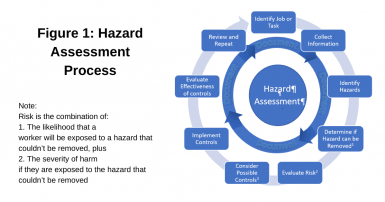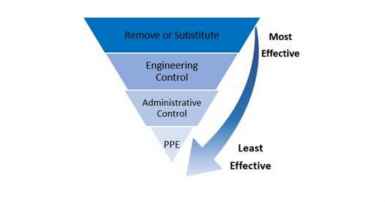If you’re working during this pandemic, it’s essential that your employer takes additional health and safety precautions to limit exposure to the virus that causes COVID-19. This applies whether you are returning to the workplace, or you never left.
The following provides general guidance and leading practices for CUPE members to consider as we continue to work through the time of COVID-19.
Download a copy of this fact sheetCOVID-19 and the principles of occupational health and safety
“COVID-19” is the common name of the respiratory infection responsible for the current global pandemic. The virus that causes the disease COVID-19 is referred to as the Novel Coronavirus, or its scientific designation, SARS-CoV 2. Coronaviruses are a large family of viruses that cause illness ranging from the common cold to more severe diseases such as Middle East Respiratory Syndrome (MERS) and Severe Acute Respiratory Syndrome (SARS). On March 11, the World Health Organization declared COVID-19 a global pandemic.
In response to the pandemic, several provinces and municipalities declared states of emergencies and issued emergency orders. Despite these declarations and orders, health and safety legislation has not changed – and neither have your rights. Workers maintain their right to know, their right to participate, their right to refuse work where there is a danger to health and safety, and their right to be free from reprisal for exercising these rights under the law.
As restrictions are partially or completely lifted, employers must continue to provide information, instruction and training to protect the health and safety of workers. Additionally, an employer must continue to provide a safe working environment at the workplace by eliminating or adequately controlling workers’ exposure to COVID-19.
The way we apply health and safety prevention in the workplace has not changed during the pandemic. Workplaces should follow the hierarchy of controls where the best precautions are “at the source” first, then “along the path” and finally “at the worker”. Where elimination or substitution of the hazard is not possible at the source, engineering and administrative controls along the path must be implemented first, before consideration is given to Personal Protective Equipment (PPE) at the worker.
Route of exposure
The Novel Coronavirus, the virus that causes COVID-19, is primarily transmitted through exposure to respiratory droplets from infected persons. These droplets are most commonly transmitted when an infected person coughs or sneezes. However, recent research shows that some droplets can be produced and projected when a person breathes or speaks. People who have been infected but are pre-symptomatic or asymptomatic are still able to spread the virus. This means effective hazard controls should focus on preventing contact within two meters of any person, even if they appear to be healthy.
Return-to-work agreements
Your local should insist on a negotiated return-to-work agreement with your employer to ensure that all workers’ return to work is safe. This return-to-work agreement should ensure that the joint health and safety committee (or worker representative) continues to participate in the development and monitoring of safe work procedures, including any changes that are made to the workplace in response to the COVID-19 pandemic.
Note: Your collective agreement may contain overlapping language on accommodation, duty to accommodate and other obligations. Remember to coordinate the various aspects of return-to-work with your CUPE National Representative. Employer and committee responsibilities are described below.
Physical distancing continues
CUPE continues to push for physical distancing for workers and visitors at all workplaces and urges employers to set up physical barriers (such as plexiglass shields) wherever feasible.
Physical distancing measures include:
a) Keeping 2 meters (6 feet) apart from others in all directions
b) Avoiding mass gatherings to what can be accommodated with distancing requirements
c) Avoiding crowds of all sizes.
These practices can help with physical distancing:
- Implement, or continue to implement, work-from-home policies
- Revise work schedules and/or create staggered shifts (where possible) to limit the number of workers on-site at a given time
- Set up one-way travel paths for aisles and one-way exits and entrances and stairwells. These should be well marked with tape or with other indicators or signs
- Post lower occupancy limits for a given space, and limiting elevators and other small spaces to only one person
- Stagger break times to limit the number of workers in a break location at a given time
- Reduce in-person meetings and other gatherings
- Post signage to remind workers to maintain their distance when interacting
- Re-arrange or plan work tasks in such a way that workers are not required to work in close proximity to each other
- Use machines or other equipment to assist with job tasks usually performed by two workers, such as lifting or carrying heavy objects
- Manage worker transportation so that multiple workers are not required to travel together in a vehicle without PPE.
It may not always be practical to eliminate work that causes workers to be within two metres of each other. In such cases, employers need to keep time spent closer together as brief as possible, through planning the work tasks and providing instructions to workers.
If workers need to constantly interact closely, employers must provide additional personal protective equipment (see fact sheet on PPE and respiratory protection).
Health and Safety Committees should also be aware of the hazards that arise from working alone and demand that the employer ensure that any such risks are avoided or otherwise controlled.
Reopening of buildings
Prior to reopening locations to workers and members of the public, it is recommended that employers inspect the buildings to ensure that equipment and systems are running correctly and there are no hazards related to being closed that could pose a risk to health and safety.
Here are a few examples:
- HVAC systems should be serviced to ensure proper air exchanges
- HVAC systems with evaporating condensers/cooling towers should be checked for standing water
- Filters in HVAC systems should be changed
- Plumbing systems should be flushed to remove standing water in pipes
- Fire alarm/safety systems, emergency lights and exit signs and fire extinguishers should be checked
- Check fridge or kitchen for foods that were left and have spoiled
- Consider where animals (pests, birds) may have entered the building and created nests, and inspect for evidence of other wildlife, including potentially deceased animals
- Ensure workers are instructed to check personal lockers or other storage space for spoiled food
Employer responsibilities
Employers are required to take reasonable steps to ensure the health and safety of workers and other parties at their workplace. That includes preventing worker exposure to the Novel Coronavirus that causes COVID-19.
This is best accomplished by creating an exposure control plan that follows the guidelines established by the various provincial and federal public health agencies. The plan should also include any additional control measures to prevent worker exposure. The employer has ultimate responsibility for the workplace, but they must take steps to facilitate the participation of and consultation with health and safety committees or representatives.
Employers must:
- Regularly communicate with the health and safety committee (or representative)
- Continue health and safety committee meetings at least as often as required by the legislative requirements (bearing in mind that more meetings are recommended during this pandemic situation). If the members are not at the workplace, conference calls or other digital communication methods are acceptable to hold meetings. Remote or off-site meetings are also acceptable if larger spaces are needed to maintain physical distancing
- Maintain appropriate records of meetings
- Implement policies and programs, in consultation with committees or representatives, that ensure worker safety. These should cover all aspects of occupational health and safety, including infection prevention and control in accordance with minimum standards legislation and the negotiated provisions of collective agreements
- Provide health and safety committee members and workers regularly updated information about changes in processes, new cleaning methods, new PPE or other new equipment, etc.
- Train workers on any new processes and new equipment that might create hazards for workers, and
- Take every reasonable precaution to protect worker health and safety.
Health and safety committee duties
The union’s right to participate in workplace health and safety remains the same. The health and safety committee or representative must be involved in the development of control plans for different job tasks.
Additionally, health and safety committees must:
- Identify situations that may be unhealthy or unsafe for workers, and advise on effective systems for responding to those situations
- Perform regular inspections of the entire workplace (large workplaces can be done in sections)
- Consider and promptly deal with complaints relating to the health and safety of workers
- Consult with workers and the employer on issues related to occupational health and safety and the occupational environment
- Make recommendations to the employer and workers for improving the occupational environment
- Advise the employer on programs and policies required under workplace regulations, and monitor their effectiveness
- Advise the employer on proposed changes to the workplace, including significant proposed changes to equipment and machinery, or the work processes that may affect the health or safety of workers
- Ensure there is a mechanism in place where workers can raise any concerns about the risk of COVID-19 exposure at the workplace to the joint committee or worker representative
- Have committee members participate in a walk-through assessment of the work process(es) to identify potential areas of increased risk and priority action
- Ensure that the joint committee or worker representative is involved in the development of control plans for different job tasks
- Get your joint committee involved in promoting approved social distancing measures
- Have your joint committee provide feedback on the effectiveness of control measures, and other COVID-19-related measures, that the employer has implemented.
Hazard assessment
 Health and safety committees should review hazard assessments for each job in light of COVID-19 to prevent exposure. The hazard assessment process can be seen in Figure 1. This is not a singular linear process that can be completed once and then forgotten. It is a continual review that requires existing controls to be re-evaluated when situations change.
Health and safety committees should review hazard assessments for each job in light of COVID-19 to prevent exposure. The hazard assessment process can be seen in Figure 1. This is not a singular linear process that can be completed once and then forgotten. It is a continual review that requires existing controls to be re-evaluated when situations change.
Hierarchy of controls
Once hazards have been identified, health and safety committees and representatives should review each one to ensure that adequate controls are in place. Committees should consider the hierarchy of controls when considering which protective measures should be selected:
- Controls should adequately control the hazard and not create any new hazards
- Controls should allow a worker to perform a task without discomfort or restriction
- Controls should not be selected because they are the easiest
- Administrative controls and PPE are the least effective types of control and should not be used exclusively to control risk. These lower stages assist in the control of risk but are rarely sufficient or thorough enough if used alone
NOTE: Specific guidance for recommended practices has been provided for multiple CUPE sectors and occupations have been posted here.
Exposure to COVID-19 in the workplace
If you believe you have been exposed, immediately inform your supervisor and follow public health instructions. Once you have addressed your immediate health concerns, complete the appropriate workers’ compensation reporting form. The documentation will assist in showing causation and connection to the workplace if you become sick. Send a copy of the completed forms to your workers’ compensation system and to your CUPE local and keep a copy for your records.
Employee responsibilities
Employees are required to adhere to safe work practices and procedures implemented by their employer. This includes using, as directed, any prescribed personal protective equipment and safe work practices established as part of the workplace exposure control plan. In the event of disagreement with prescribed practices, members should report concerns immediately to a supervisor. In the event of a dangerous situation, members in all provinces have the right to refuse to unsafe work.
Stay home if you are sick
Anyone with COVID‐19-like symptoms such as a sore throat, fever, sneezing, or coughing must self‐isolate at home for a minimum of 10 days from the onset of symptoms, until their symptoms are completely resolved. Anyone who lives in the same household as a person who has a confirmed case of COVID-19 should self-isolate as well.
Follow the Public Health Agency of Canada’s steps for self-assessment here.
Performing work not usually part of your job
Many workers are being asked to work in new locations or perform work that is not normally part of their duties. The employer must provide instructions, information, and training, along with any PPE required to do the work safely.
For members delivering such things as supplies, medicines, or food to a client’s home or entering a home, the employer should incorporate that into their screening protocol. For example, screening protocols should include conducting screening questions remotely prior to arriving at a client’s home. If done at the door, screening should take place with appropriate worker PPE upon arrival. Finally, employers should provide guidance for dealing with contaminated waste in all its forms.
Increased sanitation practices
Soap is the most effective method of destroying the virus. This means employers should provide increased time and proper facilities for personal handwashing. Other disinfection methods (such as alcohol-based disinfection) should be implemented where hand washing is not available (see the CUPE cleaning and disinfection sheet).
All common areas and surfaces should be regularly cleaned, including washrooms, shared offices, common tables and desks. Frequently touched items, often called “touch points”, such as light switches, elevator buttons and door handles, should be cleaned and disinfected more often.
Hand hygiene and respiratory (cough) etiquette
- Cover your mouth and nose when coughing or sneezing.
- Use tissues and throw them away.
- Clean your hands often. Use soap and water, or an alcohol-based hand rub.
- When washing your hands, use soap and water and scrub for at least 20 seconds


